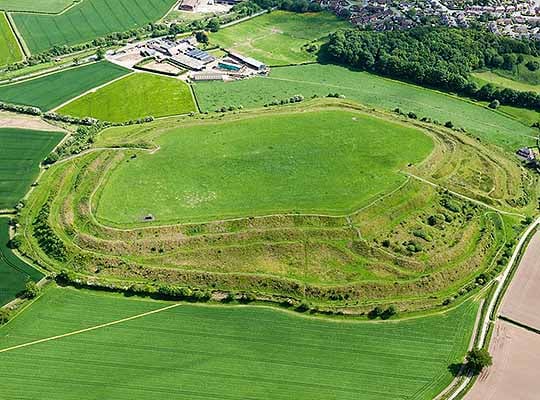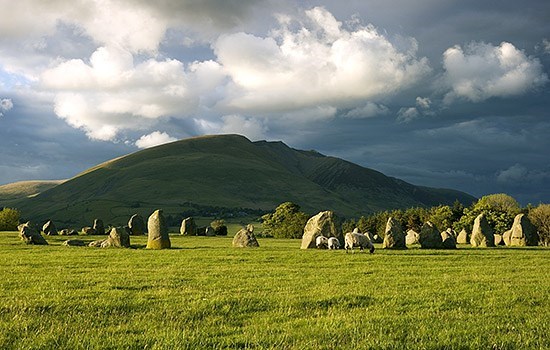History of Old Oswestry Hillfort
Old Oswestry was built and occupied during the Iron Age (800 BC to AD 43) and is one of the best-preserved hillforts in Britain. During this period Britain was divided into numerous tribal territories, and the hillfort was probably a stronghold and principal settlement for one of these. A fine example of a ‘multi-vallate’ or multiple rampart hillfort, it is one of a dense band of hillforts in eastern Wales and the Marches. It remained in use for almost 1,000 years.

The Ramparts
Much of the information about the site comes from excavations conducted in 1939 by William Varley, but only published in the 1990s. Varley’s excavations showed that the complex defensive ramparts that surround the hillfort were not built at the same time and that there were four distinct phases in their development.
These banks and ditches would have been formidable obstacles to any attacker, but they may also have been built for the purposes of display, with their dramatic appearance symbolising the dominance and power of the hillfort and its inhabitants.
There were four main phases of construction:
- The two innermost ramparts were the first to be built, in the early Iron Age. They enclosed the whole hilltop and consisted of a clay core, supported by timber and boulders and covered with earth, known as a box rampart. In several places, these boulders can be seen protruding from the ramparts.
- Next, probably in the middle Iron Age, there was a period of reorganisation in the fort. The existing ramparts were repaired and enlarged, perhaps in anticipation of an attack. A third rampart was added to the western half of the hillfort.
- Later, the third rampart was massively reconstructed and the complex of pits near the western entrance was created.
- Finally, two enormous ramparts were added to the fort. These later ramparts were built in a continual slope, or glacis, up to the crest of the rampart.
Life inside the Hillfort
People used the hilltop from the Neolithic period through to Roman times, but the main settlements here date to the later Bronze Age and Iron Age (from about 1000 BC to AD 43).
The discovery of a stone axe and flint tools here suggests that the hill was first occupied in the Neolithic period. The first direct evidence of a settlement, however, dates to about 1000 BC, before the first ramparts were built.
The settlement appears to have been surrounded by some sort of palisade or fence. Each roundhouse was built using wooden posts with wattle-and-daub walls. A central post probably supported a thatched roof and inside was a hearth. A pottery crucible was discovered in one of the hearths, showing that light industrial activities such as bronze melting were taking place within the hillfort.
By the early Iron Age, when the first two ramparts were built, the settlement was formed of stone-kerbed roundhouses. Two houses found during excavations were 7 metres in diameter, and again had central hearths. Several sherds of early Iron Age (7th century BC) furrowed pottery had been imported from the Wiltshire area as well as salt containers from Cheshire, showing that the community had long-distance trading links at this time.
Evidence for occupation after the two final ramparts were built consists of curious stone circular structures, each divided into two compartments by an internal stone division. These may date to the later Iron Age but their exact date is unknown.
Aerial photography has shown evidence of possible Iron Age settlements and field systems nearby. Surplus produce from these farms could have supported the inhabitants of the hillfort, and perhaps supplied the labour needed to construct and repair the ramparts. It is possible that Old Oswestry was a place of refuge for this outlying population at times of conflict.
After the Hillfort
After the hillfort had been abandoned it was incorporated into an earthwork known as Wat's Dyke.
Wat's Dyke is one of a number of linear earthworks in the Welsh borders, and is similar to the longer Offa’s Dyke. This was probably built by King Offa in the 8th century to separate his Anglo-Saxon kingdom of Mercia from the British kingdoms in Wales.
Unlike Offa, ‘Wat’ is not a known historical figure and recent dating evidence suggests that Wat’s Dyke was probably built some time before Offa’s Dyke. It may have been an earlier border between the Anglo-Saxon and British population, or perhaps it defined the western boundary of a now forgotten kingdom which ruled the Shropshire/Cheshire area in the post-Roman period.
During the First World War the hillfort was used as a military training area for troops based at the nearby Park Hall camp. The poet Wilfred Owen, who was born nearby, completed his army training here. Trenches were dug and the use of explosives created shallow craters that are sometimes mistaken for archaeological features. Much of the archaeology of the interior of the fort was damaged at this time.
Further Reading
Hughes, G, ‘Old Oswestry Hillfort: excavations by WJ Varley 1939–40’, Archaeologia Cambrensis, 143 (1996), 46–91
Martin, P, ‘The historical ecology of Old Oswestry’, Shropshire Botanical Society Newletter, autumn 1999, 11–12 (accessed 15 Sept 2014)
FIND OUT MORE



